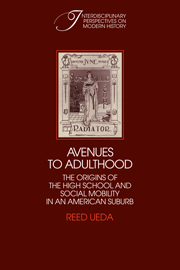Book contents
- Frontmatter
- Contents
- Acknowledgments
- Introduction
- 1 Farm village to commuter suburb
- 2 The evolution of educational leadership
- 3 The free high school
- 4 The rise of Yankee city and the prolongation of schooling
- 5 Popularizing high school: “the college of the people”
- 6 The origins of high school youth culture
- 7 Educational opportunity and social mobility
- 8 The birth of progressive reform and the junior high school
- Conclusion: The high school in the light of history
- Appendix I Courses of study
- Appendix II Sources and methods
- Appendix III Students and households
- Appendix IV Supplementary household data
- Notes
- Index
8 - The birth of progressive reform and the junior high school
Published online by Cambridge University Press: 04 August 2010
- Frontmatter
- Contents
- Acknowledgments
- Introduction
- 1 Farm village to commuter suburb
- 2 The evolution of educational leadership
- 3 The free high school
- 4 The rise of Yankee city and the prolongation of schooling
- 5 Popularizing high school: “the college of the people”
- 6 The origins of high school youth culture
- 7 Educational opportunity and social mobility
- 8 The birth of progressive reform and the junior high school
- Conclusion: The high school in the light of history
- Appendix I Courses of study
- Appendix II Sources and methods
- Appendix III Students and households
- Appendix IV Supplementary household data
- Notes
- Index
Summary
On the threshold of the twentieth century, Somerville Yankees looked ahead to a continuing partnership between Republican supremacy and business prosperity. The Yankee regime's municipal policies had galvanized population growth and economic expansion, but these became the very forces that eroded the foundations of Republican power. As the decades of the new century unfolded, the old-stock elite discovered that the relentless movement of mobile newcomers to Somerville was turning their Yankee Republican suburb into an immigrant Democratic city that resembled the ethnic neighborhoods of Boston.
Somerville Republicanism and nativism retreated before the floodtide of immigrants and workers unleashed by the maturation of the industrial economy, the affordable suburban housing market, and rapid transit. In 1926, the Republican-controlled city government gerrymandered ward two to concentrate the Irish into one voting bloc. This maneuver brought only a brief interval of safety. In 1929, “The Banner Temperance City of the Commonwealth” fell to the invaders, when for the first time in history, a Democratic mayor and a Democratcontrolled board of aldermen were elected.
A growing zone of emergence
In the early twentieth century, Somerville's role as a “zone of emergence” in the social geography of the Boston metropolitan region reached new magnitude. This inner-suburban area attracted upperworking-class and low-white-collar employees with its cross town rapid transit and inexpensive housing conditions. Second-generation northern European, Canadian, and Irish immigrants on the rise had filtered into the Somerville “zone” since the late nineteenth century, but their flow speeded up and was infused by new arrivals from southern and eastern Europe. These newcomers gradually displaced the Yankees, and in the process, they transformed the housing market.
- Type
- Chapter
- Information
- Avenues to AdulthoodThe Origins of the High School and Social Mobility in an American Suburb, pp. 186 - 219Publisher: Cambridge University PressPrint publication year: 1987



